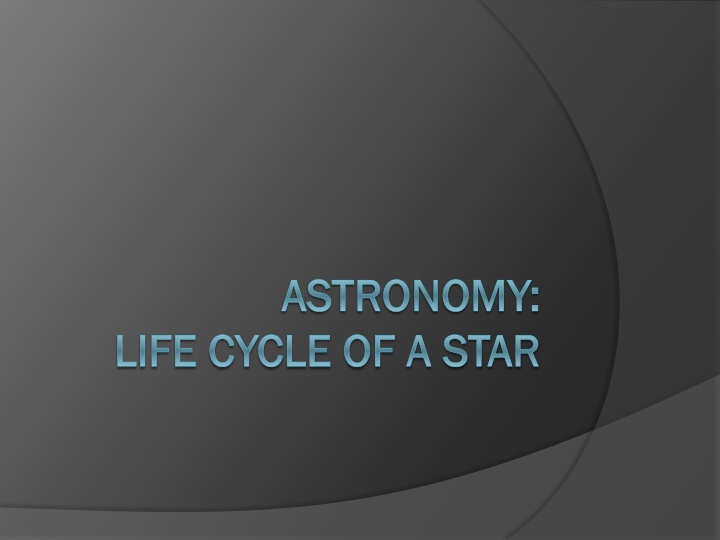
Life Cycle of Stars
Explore the fascinating journey of stars through their life cycle, from formation in stellar nebulas to transformations into red giants, white dwarfs, and even supernovas. Learn about luminosity, stellar classification, and key stages in a star's evolution.
Download Presentation

Please find below an Image/Link to download the presentation.
The content on the website is provided AS IS for your information and personal use only. It may not be sold, licensed, or shared on other websites without obtaining consent from the author. If you encounter any issues during the download, it is possible that the publisher has removed the file from their server.
You are allowed to download the files provided on this website for personal or commercial use, subject to the condition that they are used lawfully. All files are the property of their respective owners.
The content on the website is provided AS IS for your information and personal use only. It may not be sold, licensed, or shared on other websites without obtaining consent from the author.
E N D
Presentation Transcript
ASTRONOMY: ASTRONOMY: LIFE CYCLE OF A STAR LIFE CYCLE OF A STAR
Lesson Goals 1. Define the terms: Luminosity, Stellar Classification, Stellar Nebulae, Red Giant, White Dwarf, Supernova, Neutron star, and Stellar Black Hole. 2. Describe the life cycle of a star.
Classification of Stars 2 Types of star classification: luminosity and stellar classification. Luminosity: the brightness of a star. Sirius A is the brightest star, other than the sun, at -1.4. The dimmest stars that can be seen with the naked eye are called 6thmagnitude stars. The dimmest stars that can be seen with the Hubbell telescope are 30thmagnitude.
Stars can also be described by their stellar classification, which is based on color and temperature. It also lets astronomers know where the star is at in its life cycle.
Life Cycle of a star 1) The cycle of a star begins with the formation of a cloud of gas (hydrogen) and dust called a Stellar Nebula. The gas and dust begin to swirl and clump. As it clumps, it pulls material into the core. As the star grows, the cloud surrounding the star is vaporized.
Life Cycle of a star 2) When the core temp reaches about 1 million degrees celsius, the gases combine and a large amount of energy is produced over a long period of time.
Life Cycle of a star 3) Eventually most of the core hydrogen is changed to helium. Then, the helium begins to change into carbon and the star begins to expand. As it expands, its outer layers begin to cool. The star becomes a Red Giant.
Life Cycle of a star 4) What happens next depends on the mass of the star: Stars begin to lose their mass due to stellar winds. a. Stars the size of the sun and smaller: the outer layers fall off to leave a nebula, and the core cools. The core becomes a White Dwarf, giving off heat as it is stored. b. Stars three times larger than the sun: The star becomes a supergiant. These stars may explode, producing a Supernova.
Life Cycle of a star 5) After most of the mass is lost in the explosion, what is left behind is a tiny neutron star. 6) If the star is massive enough, the neutron star implodes to make a stellar black hole, where gravity is so strong that not even light can escape.
How long do stars live? It depends on the size of the star. Smaller, cooler stars burn their fuel much more slowly hence they live longer. (20 billion years) Even though they have more fuel, large/hot stars burn their fuel much more quickly. Their lives are much shorter. (tens of millions of years)
Journal Question What determines how a star dies? Explain
